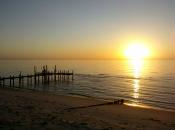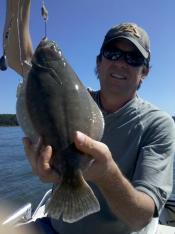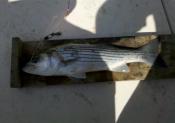 In my very limited previous experience while fishing saltwater, the thing that sticks in my mind most clearly is how just about every species I’ve ever caught can pull so hard. Blistering runs, long drawn out battles, and burning arms can be the norm when fishing off-shore. So, when given the opportunity to fish Virginia’s Eastern Shore with a friend who’s got just a bit of history back there (dating back to the late 1600’s), I jumped at the chance to learn what I could. As it turned out, the fishing that we did while full of its own very unique twists and wrinkles, was more similar to the freshwater fishing I typically enjoy. Near-shore angling at its finest, the Chesapeake Bay area boasts an incredible number of opportunities for an even more staggering array of species. From what I had heard out there, the off-shore deep water fishing was pretty good too, though we were plenty preoccupied with the tidal creeks we fished daily.
In my very limited previous experience while fishing saltwater, the thing that sticks in my mind most clearly is how just about every species I’ve ever caught can pull so hard. Blistering runs, long drawn out battles, and burning arms can be the norm when fishing off-shore. So, when given the opportunity to fish Virginia’s Eastern Shore with a friend who’s got just a bit of history back there (dating back to the late 1600’s), I jumped at the chance to learn what I could. As it turned out, the fishing that we did while full of its own very unique twists and wrinkles, was more similar to the freshwater fishing I typically enjoy. Near-shore angling at its finest, the Chesapeake Bay area boasts an incredible number of opportunities for an even more staggering array of species. From what I had heard out there, the off-shore deep water fishing was pretty good too, though we were plenty preoccupied with the tidal creeks we fished daily.
 The Eastern Shore is an interesting place, sort of where the northeastern US and the South collide, both figuratively and literally. Nothing more than a large peninsula of sand that serves as a barrier between the Chesapeake Bay and Atlantic Ocean, the area is home to a vast system of coastal plains, estuaries, saltwater marshes, and wetlands. We were lucky enough to catch much of the seafood in-season, with watermen out pulling crab-pots and nets about everywhere we fished. Small roadside stands similar to the way we’re used to buying sweet-corn, was where we purchased all of our seafood. Held in large blue coolers, this stuff was straight from the watermen themselves thus cutting out the middlemen and about half the cost. The blue crab was king in my mind, both tasty and common, with them almost being pests wherever we dropped a line. That said, we also sampled a laundry list of other local eats, including everything from Swellin’ Toad (Pufferfish) to Scrapple (fried meat mush formed from pig head, heart, liver, and other scraps). Of course, oysters, clams, shrimp, crab, flounder, and softshells were far more edible.
The Eastern Shore is an interesting place, sort of where the northeastern US and the South collide, both figuratively and literally. Nothing more than a large peninsula of sand that serves as a barrier between the Chesapeake Bay and Atlantic Ocean, the area is home to a vast system of coastal plains, estuaries, saltwater marshes, and wetlands. We were lucky enough to catch much of the seafood in-season, with watermen out pulling crab-pots and nets about everywhere we fished. Small roadside stands similar to the way we’re used to buying sweet-corn, was where we purchased all of our seafood. Held in large blue coolers, this stuff was straight from the watermen themselves thus cutting out the middlemen and about half the cost. The blue crab was king in my mind, both tasty and common, with them almost being pests wherever we dropped a line. That said, we also sampled a laundry list of other local eats, including everything from Swellin’ Toad (Pufferfish) to Scrapple (fried meat mush formed from pig head, heart, liver, and other scraps). Of course, oysters, clams, shrimp, crab, flounder, and softshells were far more edible.
 As for the fishing, it was fair to good depending on the day and tidal flow. Everything out there happens by the tide, with these marshes being too shallow for navigation without the ebb/flow of the high tide. Residents actually have a “tidal clock” that they look at far more closely than they do any standard wall clock. A typical jaunt involved finding incoming or outgoing flow, then completing drifts with baited snelled hooks fished near bottom on the edges of cover, docks, and/or current seams. Much like river fishing, our best success was within the first hour of outgoing tide near manmade breaks and current seams that concentrated active feeding fish. Speckled trout were the most common catch in these areas, and one of the better fighting fish sans the flounder and striped bass we caught. Most fish were a bit on the smaller side compared to average, but the diversity of species caught was astounding. They included mullet, spot, speckled trout, gray trout, swellin’ toad (pufferfish), perch, black sea bass (wills), black drum, sheepshead (perch), stripers, flounder, bluefish, tautog, and plenty of blue crab.
As for the fishing, it was fair to good depending on the day and tidal flow. Everything out there happens by the tide, with these marshes being too shallow for navigation without the ebb/flow of the high tide. Residents actually have a “tidal clock” that they look at far more closely than they do any standard wall clock. A typical jaunt involved finding incoming or outgoing flow, then completing drifts with baited snelled hooks fished near bottom on the edges of cover, docks, and/or current seams. Much like river fishing, our best success was within the first hour of outgoing tide near manmade breaks and current seams that concentrated active feeding fish. Speckled trout were the most common catch in these areas, and one of the better fighting fish sans the flounder and striped bass we caught. Most fish were a bit on the smaller side compared to average, but the diversity of species caught was astounding. They included mullet, spot, speckled trout, gray trout, swellin’ toad (pufferfish), perch, black sea bass (wills), black drum, sheepshead (perch), stripers, flounder, bluefish, tautog, and plenty of blue crab.
 Most fish were caught on peeler crab; these are young blue crab ready to shed their hard-shells. At this stage, the peelers hold together nicely on a hook without having to crack the tough exoskeleton of your avg. hard-crab. Everything ate it, including other crabs. Imitation bloodworm and some artificial were used especially for the large stripers that had a habit of breaking me off near the numerous docks, poles, pilings, and other manmade structures they continually frequented. I was far too under-sticked to do battle with the likes of them, but it didn’t stop me from trying. More impressive however, was the fact that your average Minnesotan could apply freshwater lessons to these areas and probably expect to do alright. Pitching jigs/plastics to shorelines surely produced big bites, as did drifting bottom rigs with the correct bait. Having local knowledge was still the premium however, as just the navigation was incredibly tricky depending on the tide, let alone bait selection and general familiarity with areas that historically produced well. All-in-all, it was an experience I won’t soon forget, with the fishing taking a backseat at times to both the scenery and the eats.
Most fish were caught on peeler crab; these are young blue crab ready to shed their hard-shells. At this stage, the peelers hold together nicely on a hook without having to crack the tough exoskeleton of your avg. hard-crab. Everything ate it, including other crabs. Imitation bloodworm and some artificial were used especially for the large stripers that had a habit of breaking me off near the numerous docks, poles, pilings, and other manmade structures they continually frequented. I was far too under-sticked to do battle with the likes of them, but it didn’t stop me from trying. More impressive however, was the fact that your average Minnesotan could apply freshwater lessons to these areas and probably expect to do alright. Pitching jigs/plastics to shorelines surely produced big bites, as did drifting bottom rigs with the correct bait. Having local knowledge was still the premium however, as just the navigation was incredibly tricky depending on the tide, let alone bait selection and general familiarity with areas that historically produced well. All-in-all, it was an experience I won’t soon forget, with the fishing taking a backseat at times to both the scenery and the eats.
Joel